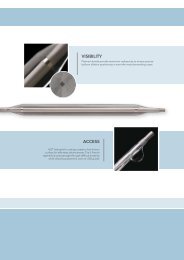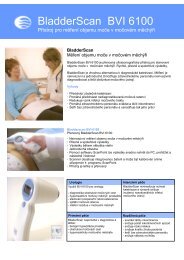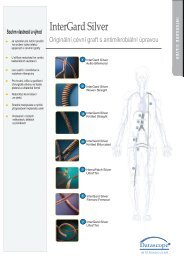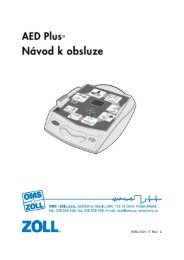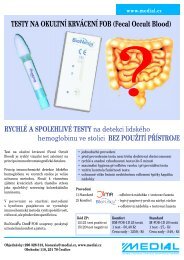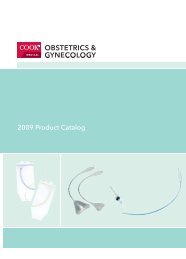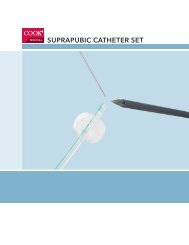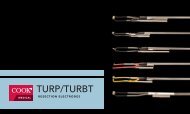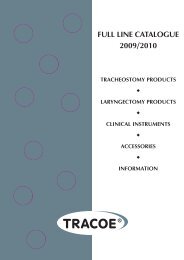The BAP test and the global assessment of oxidative stress ... - Medial
The BAP test and the global assessment of oxidative stress ... - Medial
The BAP test and the global assessment of oxidative stress ... - Medial
You also want an ePaper? Increase the reach of your titles
YUMPU automatically turns print PDFs into web optimized ePapers that Google loves.
On <strong>the</strong> o<strong>the</strong>r h<strong>and</strong>, in experimental trials, ithas been shown that <strong>the</strong> <strong>BAP</strong> resultssatisfyingly correlate with those <strong>of</strong> FRAP, whichis considered <strong>the</strong> comparison method <strong>the</strong> mostsimilar to <strong>BAP</strong> <strong>test</strong>, in <strong>the</strong> actual panorama <strong>of</strong>all <strong>the</strong> assays proposed to evaluate <strong>the</strong> plasmaantioxidant capacity.Indeed, <strong>the</strong> FRAP assay is based on <strong>the</strong>reduction <strong>of</strong> ferric tripyridyltriazine (Fe III -TPTZ)to ferrous tripyridyltriazine (Fe II -TPTZ), whichdevelops an intense blue color, phometricallymeasurable by setting <strong>the</strong> wavelength to 593nm (21). <strong>The</strong> calibration may be performed bymeans <strong>of</strong> solutions with known concentrations<strong>of</strong> Fe II (FeSO 4 . 7H 2 O). Analogously, <strong>the</strong> <strong>BAP</strong> <strong>test</strong>is based on <strong>the</strong> use <strong>of</strong> a colored solution whichis obtained by adding a source <strong>of</strong> ferric ions toa chromogenic mixture.<strong>The</strong> entity <strong>of</strong> decoloration is <strong>the</strong>n assessedby measuring <strong>the</strong> absorbance at 505 nm,which is proportional to <strong>the</strong> reducing activity <strong>of</strong><strong>the</strong> sample.According to <strong>the</strong>se observations, Vassalle(unpublished data) recently assessedcomparatively analytical performance <strong>of</strong> <strong>BAP</strong><strong>and</strong> FRAP <strong>test</strong> on 18 samples <strong>of</strong> human bloodplasma.According to <strong>the</strong> result <strong>of</strong> this study, meanvalue (± SD) <strong>of</strong> <strong>BAP</strong> <strong>test</strong> was 3163±770 µEq/L,while <strong>the</strong> mean value (± SD) <strong>of</strong> FRAP <strong>test</strong> was521±132 µmol/L.<strong>The</strong> correlation between <strong>test</strong> was shown tobe acceptable in 16/18 <strong>test</strong>ed sample(88.89%).<strong>The</strong> remaining two samples were shown tonot correlate, maybe to <strong>the</strong> higher level <strong>of</strong>plasma lipids, which can interfere with <strong>the</strong>photometric readings <strong>of</strong> every photometric <strong>test</strong>(Figure 7).FRAP <strong>test</strong> (µmol/L)FRAP (µmol/l)80070060050040030020010001500 2000 2500 3000 3500 4000 4500<strong>BAP</strong> <strong>test</strong> (µEq/L)Figure 7. Comparative evaluation <strong>of</strong> <strong>BAP</strong> <strong>test</strong> <strong>and</strong>FRAP assay (modified by Vassalle et al, 2006)(Unpublished data).4. Procedure<strong>BAP</strong> <strong>test</strong> can be performed ei<strong>the</strong>r onwhole blood or heparinised blood plasma orserum. Such samples should be fresh, in orderto avoid an eventual underestimation <strong>of</strong> <strong>the</strong>results due to possible auto-oxidationphenomena.<strong>The</strong>refore, while waiting fur<strong>the</strong>r data bystudies in progress, it is suggested tocentrifuge as soon as possible (within 1 hour)<strong>the</strong> blood <strong>and</strong> to recover plasma or serum. If<strong>the</strong> sample (plasma/serum) cannot beimmediately processed it should be stored at+4 °C <strong>and</strong> <strong>test</strong>ed within 1-to-3 days oraccording to <strong>the</strong> guidelines <strong>of</strong> laboratory goodpractice.However very recent evidence suggeststhat <strong>BAP</strong> <strong>test</strong> maintains its analytical reliabilityeven on previous frozen samples (at -80°C)<strong>The</strong> <strong>BAP</strong> <strong>test</strong> can be performed with acommon photometer, according to <strong>the</strong> exactst<strong>and</strong>ardized work conditions (Table 2).Table 2. Work conditions <strong>of</strong> <strong>BAP</strong> <strong>test</strong>.Wavelenght Optical path Temperature Mode505 nm 1 cm 37 °C DifferentialHowever, due to some practical reasons,<strong>the</strong> <strong>test</strong> can be performed also with dedicatedanalytical devices, like FREE system (DIACRONInternational s. r. l., Grosseto, Italy) (24), forblood plasma or serum, or FRAS 4 system(H&D s. r. l., Parma, Italy) (20) by startingform whole (capillary) blood. Both systems,which require dedicated kits, substantially limitmanual intervention to a few steps comparedto common photometers, thus reducing apossible source <strong>of</strong> analytical imprecision.Moreover, ei<strong>the</strong>r FREE or FRAS systemallows a <strong>global</strong> <strong>assessment</strong> <strong>of</strong> <strong>oxidative</strong> <strong>stress</strong>,due to <strong>the</strong> possibility to perform not only <strong>the</strong><strong>BAP</strong> <strong>test</strong> (antioxidant status <strong>assessment</strong>) butalso <strong>the</strong> d-ROMs <strong>test</strong> (oxidant status<strong>assessment</strong>) (20, 24).9www.fras4evolvo.it



